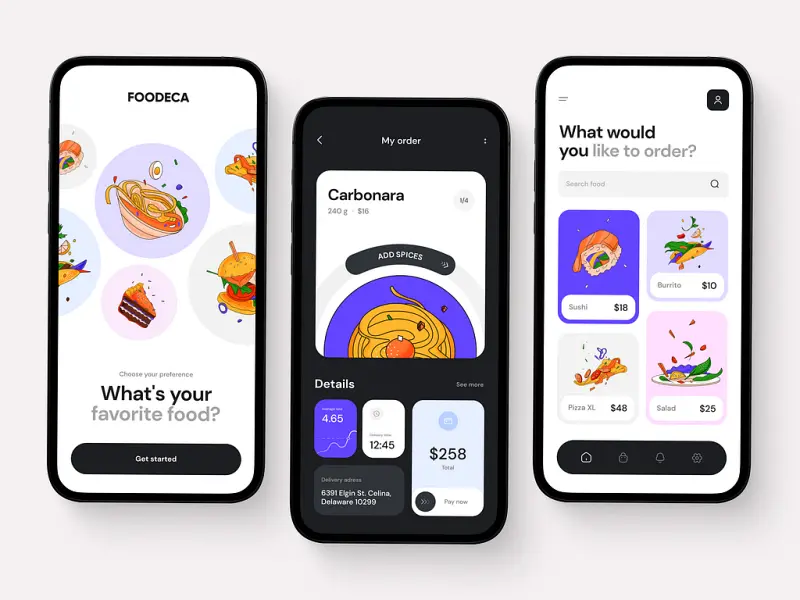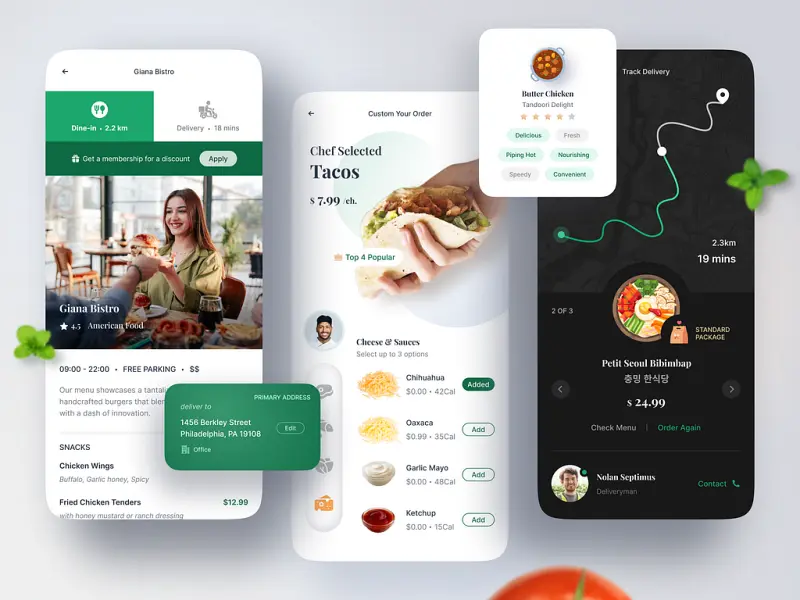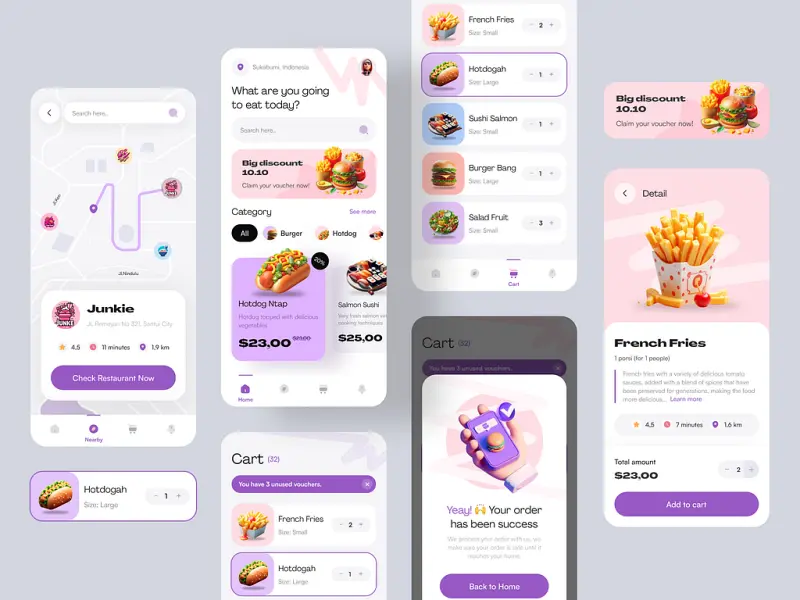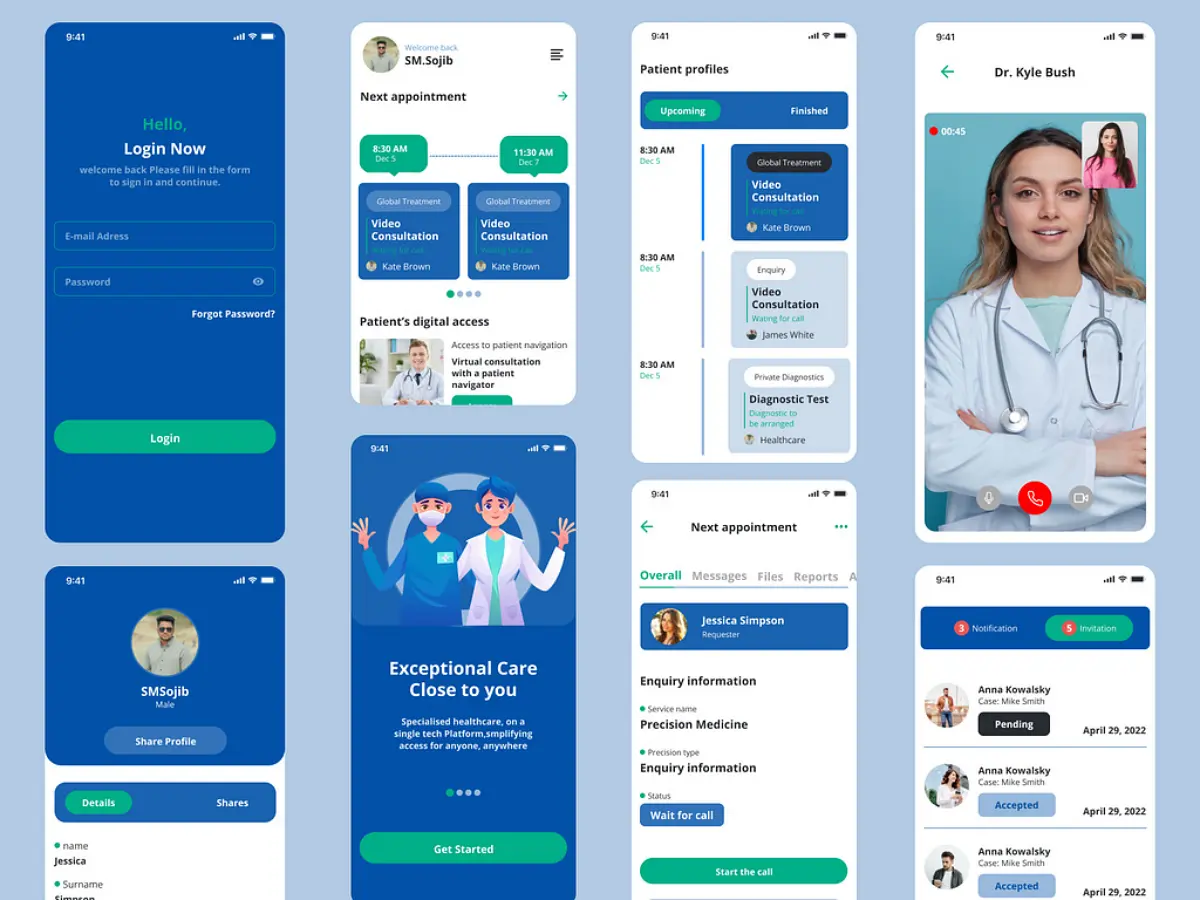Best Guide to Food Delivery Application Development in 2025
- TECHVIFY Team
- 0 Comments
Food delivery app development is one of the fastest-growing businesses worldwide. This increase is mainly driven by a growing demand for delivered meals due to the ongoing pandemic.
Based on data from Business of Apps, the user base for food delivery apps in the U.S reached 111 million by 2020 and is expected to keep rising.
Revenue is projected to grow annually at 9.89 percent (CAGR 2021-2025), leading to an estimated market volume of $441,622 million by 2025.
Additionally, the number of people ordering meals online has nearly quadrupled in the past three years, from 364.8 million in 2017 to 625.9 million in 2020.
As a result, the number of companies that provide food delivery application development services is also increasing due to this significant growth.
As a leading outsourced software app development company, we provide all the essential features a food delivery app should offer customers, restaurant owners, and drivers.
I. Most Seen Features of a Good Food Delivery App
Customer’s App Features
- Search Filter: The search filter helps users find cafes and restaurants by location and cuisine.
- Order Placement: Customers can easily place orders from their favorite restaurants. They select their food, add it to the cart, and proceed with the order.
- Real-time Location: Tracking After placing an order, customers can track their food using a geolocation map. This feature shows how long the delivery will take, building trust in the service.
- Payment Gateway: Integration Payment gateways allow users to pay online using debit/credit cards or internet banking. Restaurants receive payments through gateways like PayPal or Stripe.
- Reviews and Ratings: Customer feedback and ratings are crucial for competition. This feature lets users rate and review the app and services, helping improve customer satisfaction.
- Order History: Order history lets users view and manage past orders and easily repeat previous orders.
- Nearby Restaurants: This feature shows top and nearby restaurants based on the user’s location. Users can view menus, prices, reviews and place orders from these restaurants.

Deliver App Features
- Registration: Drivers can log in or sign-up using phone numbers, Gmail, or social media accounts. The process should be simple and quick to help new drivers join easily.
- Driver Profile: Drivers can upload their details, such as name, email address, contact information, and photo, to make it easier for users to see their basic information.
- Alerts and Notifications: This feature notifies drivers of new food orders. Even when not using the app, drivers should receive sound alerts for new orders.
- Manage Multiple Deliveries: Drivers can handle multiple delivery requests simultaneously and accept requests that are near each other.
- GPS Integration: GPS integration helps drivers find the best routes. It suggests the most convenient paths, which are useful for handling last-minute orders efficiently.
- Call/Chat Option: Drivers can use the chat or call option to contact customers if there are any issues.
- Order History: Drivers can view their delivery history and payment records with this feature.
Admin Dashboard Features
- Performance Monitoring: Admins can monitor all user and delivery personnel activities. The dashboard tracks deliveries, drivers, scheduled and canceled orders, and driver information.
- Order Management: Admins can manage all aspects of order processing, from pickups to deliveries. They ensure orders are simplified and delivered on time.
- Real-time Updates: Admins track the availability of delivery agents and restaurants. This feature provides real-time updates and notifications on profile changes, restaurant timings, and availability.
- Payment and Commission Management: Admins can manage payment and commission rates for each food order through this interface.
- Offers and Discounts: Admins can create and manage discounts and coupon codes on the app.
- Push Notifications: Admins receive alerts when drivers accept order requests and are en route for collection or delivery.
- Restaurant Management: Admins can add or remove restaurants from the app.
II. How to Do a Food Delivery Application Development In 6 Steps
Step 1: Start by Validating Your Food Delivery App Idea
Start by conducting market research. While the industry is lucrative, a few major players dominate it. As of Q1 2022, DoorDash, Uber Eats, and Grubhub control 97% of the food delivery market.
Only a small fraction of deliveries go to lesser-known brands.
This isn’t to discourage you but to set realistic expectations. Competing with giants like DoorDash and Uber Eats is challenging.
However, there’s still significant opportunity on a smaller scale. Building a food delivery app for your existing restaurant, grocery store, or convenience store can be highly beneficial. Even small businesses, like ice cream shops, can gain from food delivery apps.
This approach helps expand your business and meet customer expectations.
Additionally, having your own food delivery app cuts out the middleman, eliminating third-party fees associated with other delivery apps.
Step 2: Decide on Your Food Delivery App Development Approach
Once you’ve verified that there is a genuine market need for your food delivery app, the next step is to start the development process.
Here are the general methods you can choose from:
- Hiring an app developer
- Using a DIY app builder
- Leveraging internal resources for development
- Outsourcing to an app development agency
For most restaurants and grocery stores, having an internal IT team is unlikely, so you can rule out the option of using internal resources. Hiring a developer or outsourcing to an agency can be costly, making these options less feasible if you have budget constraints.
This leaves us with the option of building the app yourself using a DIY app builder. For most people reading this guide, an app builder is the most practical and cost-effective solution.
These platforms allow you to build a food delivery app without writing any code. Platforms like BuildFire offer simple plug-and-play features that make it easy to develop a restaurant app.

Step 3: Determine Your Food Delivery Business Model
Food delivery apps can function in different ways, and you can monetize your app idea using various models.
Delivery Services
In this model, you create and manage an app that handles all deliveries between restaurants and customers. Restaurants pay fees to use the platform; you take a commission from each order.
Third-Party Facilitator
Similar to the delivery services model, this approach connects restaurants with consumers, but the actual deliveries are managed by a third-party service. Your role is to run the app without directly handling the food.
Direct Food Delivery Apps
This model involves a restaurant or grocery store having its own dedicated app for food delivery. The business manages both the software and the order fulfillment internally.
Monetization Strategies
-
For Delivery Services and Third-Party Facilitators:
- Charge restaurants to be listed on the platform.
- Collect delivery fees or a percentage of each order.
- Offer premium subscriptions to consumers for additional perks and loyalty benefits.
-
For Direct Food Delivery Apps:
- Charge customers for food items in each order.
- Implement delivery fees or increase item prices for delivery.
- Provide a monthly subscription option to waive delivery fees, promoting customer loyalty and increasing order frequency.
Step 4: Define Essential Features
Every food ordering app needs certain key features. You might also want to add unique features specific to your business model.
We’ll discuss the critical features of a successful food delivery app later in this guide.
It’s important to understand the features you want before beginning development. Here’s why:
Your features will shape the development process from start to finish. It’s easy to add features that seem interesting during development, even if they aren’t necessary for the main purpose of your food delivery app.
Step 5: Design and Build Your Food Delivery App
With your plan ready, proceed to design and develop your app.
First, create wireframes and prototypes to outline the app’s structure and functionality.
Collaborate closely with your designers and developers to ensure that both features and aesthetics are well-coordinated. Pay special attention to UX/UI design, which is crucial for food delivery apps.
Strive to develop an app that is both responsive and scalable.
Make sure you thoroughly evaluate the app across multiple devices and operating systems to verify proper functionality.
Collect feedback regularly and make necessary improvements throughout the development phase to enhance the app.

Step 6: Market and Launch Your Food Delivery App
The final step is to launch your food delivery app. Aim to get it live on both the Apple App Store and Google Play Store to reach the widest audience.
Next, focus on marketing your app to encourage downloads.
Local restaurants and grocery stores should consider offering incentives to attract early users. A discount, such as 20% off the first order, can motivate people to try the app. Even if the initial profit is low, it’s a worthwhile investment in user acquisition.
Promote your app through various channels. Feature it prominently on your website. Use printed flyers in your restaurant or store. Send email campaigns to your subscribers. Use social media networks to extend your reach.
Maximize all efforts to drive downloads. Even before the app is live, build anticipation and excitement so potential users are ready to download it as soon as it launches.
Looking to Outsource Development?
Contact TECHVIFY – Vietnam’s Leading Offshore Software Development & Outsourcing Company, for consultation and development services.
III. Find out the Cost of Food Delivery App Development
Now, it’s time to estimate the cost of developing a food delivery app.
The cost depends on the number of features and the complexity of the project.
More features will increase the overall cost.
Based on the factors mentioned, here’s our estimate:
The cost of a mobile app is affected by several factors, including the number of platforms, features, and integrations.
Mobile developers will provide a detailed estimate after the discovery phase.
This initial phase allows you and your core team to set the groundwork for developing your food delivery app. It includes:
- Defining functional requirements
- Designing the user interface and user experience
The discovery phase helps with:
- Establishing the work scope
- Creating a project roadmap
- Setting a realistic budget for the MVP
- Planning resources
- Testing the app’s MVP with the target audience
- Building a compelling investment case
Here are the estimated hours and costs for different components:
| App Type | Timeline | Average Cost |
|---|---|---|
| User app for iOS and Android | 1,206 hours | $30,000 |
| Courier app for iOS and Android | 914 hours | $22,500 |
| Web-based solution for restaurants | 182 hours | $4,500 |
| Web-based admin panel | 257 hours | $6,000 |
| Total | 2,559 hours | $63,000 |
Keep up with current food delivery app trends and offer additional value that competitors don’t have.
If you’re unsure how to create a food delivery app, use your budget to decide whether you want an Order-Only app or an Order-and-Delivery model app.
In the second development stage, use the app MVP to gather user feedback and add more features.
IV. The Future of the Food Delivery Sector
The food delivery sector has seen significant growth, but this surge may not last forever; the pandemic-driven increase will eventually slow down. However, on-premise dining will continue to grow even after the pandemic.
According to Datassential in September 2020, 59% of food delivery consumers said they would continue using delivery apps after the pandemic ends.
With advancements in AI and the use of drones and robots, contactless food delivery is becoming more common.
The industry adopted various technologies during the pandemic to maintain safety and hygiene protocols. Customers also shifted from cash-on-delivery to cashless payments, enabling contactless deliveries. These methods reduce unnecessary in-person interactions and minimize risks.
As a result, contactless delivery has gained significant attention recently.
Conclusion
The food delivery app market is booming, driven by increased demand during the pandemic. With the right features for customers, drivers, and admins, a well-crafted app can enhance user satisfaction and streamline operations. Investing in a food delivery app isn’t just a trend—it’s a necessity to stay competitive and meet customer expectations.
Ready to revolutionize your food delivery business? Contact TECHVIFY for top-notch food delivery application development. Our experienced team will bring your vision to life with perfect solutions.
TECHVIFY – Global AI & Software Solutions Company
For MVPs and Market Leaders: TECHVIFY prioritizes results, not just deliverables. Reduce time to market & see ROI early with high-performing Teams & Software Solutions.
- Email: [email protected]
- Phone: (+84)24.77762.666





